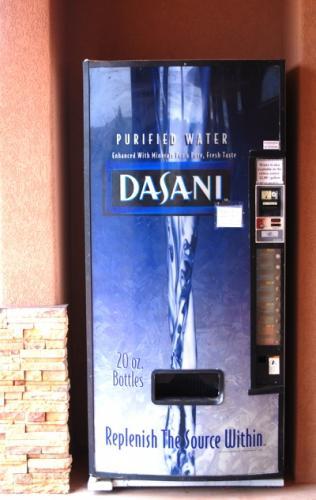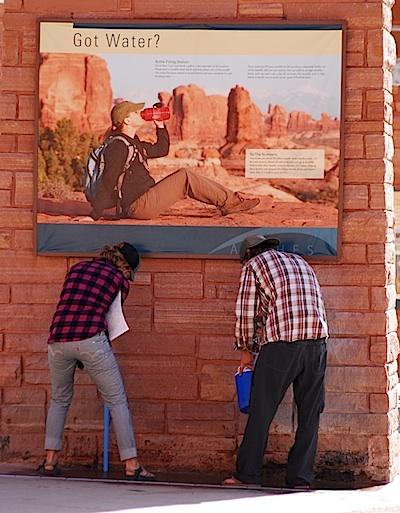
Disposable water bottle sales likely will return to many national parks following the announcement Wednesday that the National Park Service ban on the bottles was rescinded/Kurt Repanshek file photo
Editor'snote: This updates to include comment from the International Bottled Water Association, clarifies that the ban was against the sale of disposable bottles.
The Trump administration announced Wednesday an end to a controversial ban on the sale of disposable water bottles in the National Park System, a move applauded by the bottled water industry but no doubt disappointing to reusable bottle makers and organizations trying to reduce plastic waste.
In a release not immediately distributed directly to media outlets but quietly posted on its press release website, the National Park Service said its decision to overturn the ban was part of its "commitment to providing a safe and world-class visitor experience."
The 2011 policy, which encouraged national parks to eliminate the sale of disposable water bottles, has been rescinded to expand hydration options for recreationalists, hikers, and other visitors to national parks. The ban removed the healthiest beverage choice at a variety of parks while still allowing sales of bottled sweetened drinks. The change in policy comes after a review of the policy’s aims and impact in close consultation with Department of the Interior leadership.
“While we will continue to encourage the use of free water bottle filling stations as appropriate, ultimately it should be up to our visitors to decide how best to keep themselves and their families hydrated during a visit to a national park, particularly during hot summer visitation periods,” said acting Park Service Director Michael T. Reynolds.
The battle over bottled water dates to December 2011, when then-National Park Service Director Jon Jarvis gave park superintendents the option to impose a ban in a move to reduce litter in the parks and waste in landfills. Since then, nearly two dozen parks have banned their sale, and installed water stations for visitors to refill their reusable bottles and hydration packs.
But the move was never popular with the bottled water industry, and their lobbyists found allies in Congress to push back against the Park Service ban. Indeed, even before former Park Service Director Jarvis agreed to a ban, the Park Service's commitment to a green environment was partially derailed when Coca Cola in November 2011 raised concerns over plans to ban disposable water bottles at Grand Canyon National Park with the National Park Foundation and Director Jarvis, who initially blocked the ban.

Despite the ban's removal, water-filling stations likely will remain in national parks/Kurt Repanshek file photo
In coming around to agree to a ban of disposable plastic water bottles, then-Director Jarvis cited the Park Service's Green Parks Plan, which had a goal of reducing waste in the parks, in part by offering water bottle refilling stations in at least 75 percent of park visitor centers by 2016, the year the agency marks its centennial. (Note: The NPS failed to reach that goal.)
Since that 2011 directive went out, there have been occasional moves to force the Park Service to lift the ban.
Early in 2013 the bottled water industry pushed back against the ban, saying it would encourage visitors to turn to unhealthy alternatives to quench their thirsts. According to the International Bottled Water Association, research shows that in the absence of bottled water products, "63 percent of people will choose soda or another sugared drink – not tap water."
In 2015, the House of Representatives approved an amendment to overturn the ban, but then the bill it was attached to, the House Interior Appropriations bill, was pulled back due to a fight over whether Confederate flags could be displayed at national cemeteries. The Bottled Water Association at the time said the House's move to overturn the ban "is a vote for public health and safety."
Then last year the funding bill for the Interior Department drafted by the House contained language that would have blocked the Park Service from using its budget to enforce the bottle ban.
Shortly after the Park Service announced the death of the ban the International Bottled Water Association released comments approving the move.
“The International Bottled Water Association applauds this action, which recognizes the importance of making safe, healthy, convenient bottled water available to the millions of people from around the world who want to stay well-hydrated while visiting national parks,” said IBWA Vice President of Communications Jill Culora. “Consumption of water in all forms – tap, filtered, and bottled – should always be encouraged.”
Currently only 23 of the 417 National Park Service sites have implemented the policy, the Park Service said Wednesday. The revocation of the memorandum, which was put in place on December 14, 2011, is effective immediately. Parks will continue to promote the recycling of disposable plastic water bottles and many parks have already worked with partners to provide free potable water in bottle filling stations located at visitor centers and near trailheads, the agency said.



Comments
Well - just to be clear about my position - I generally agree that using common prepackaged bottled water is normally a waste of resources which I wish would be reduced. Plastic bottle waste is definitely a concern - especially given that it can't really be recycled back into food-grade plastics and that it stays in the environment for a long time. However, I do understand that there are a lot of things in life that we do that are at cross purposes with what I believe should be goals.
The NPS does have different goals in trying to reduce the likelihood of pollution, as well as visitor safety. We'd like to see people stay properly hydrated. Even in places where it's not terribly hot, NPS and other SAR have had to rescue people who didn't have enough water, including some who have died. Visitors should be encouraged to bring reusable containers and I like the new style of water fountains that can dispense vertically into tall containers or even into hydration devices.
When I've gone backpacking, NPS had many recommendations for steps I should take to reduce the likelihood of bears obtaining my food. Those included how to pack a bear canister, which often involves using additional bags to package food after being taken out of its original packaging. It was suggested that I package my waste in plastic Ziploc-style bags and possibly even double-bag in order to separate it from my food and store in the same canister. While camping I'm supposed to keep a clean camp, and that's pretty difficult to do without plastic trash bags. I certainly don't feel great about it, but sometimes there are practical concerns that come into play. I see various NPS vehicles, and many are huge gas guzzling vehicles - especially the big SUV patrol vehicles that really don't do much compared to sedans.
If anything, perhaps NPS could come to some performance standard. Many bottled water sellers have been reducing the amount of plastics used in their bottles. I know some find the newer ones to be a bit flimsy, but it's something that I'm just going to toss for recyling before perhaps refilling a few times. One those backpacking trips, that's when they just started to be using them, and I was using several of those bottles repeatedly for storing my treated water. Perhaps rules on how much plastic for a given size would be workable. However, I suspect that with the current administration that's not likely.
More commentary:
https://www.yahoo.com/news/national-parks-ditch-obama-era-192400272.html